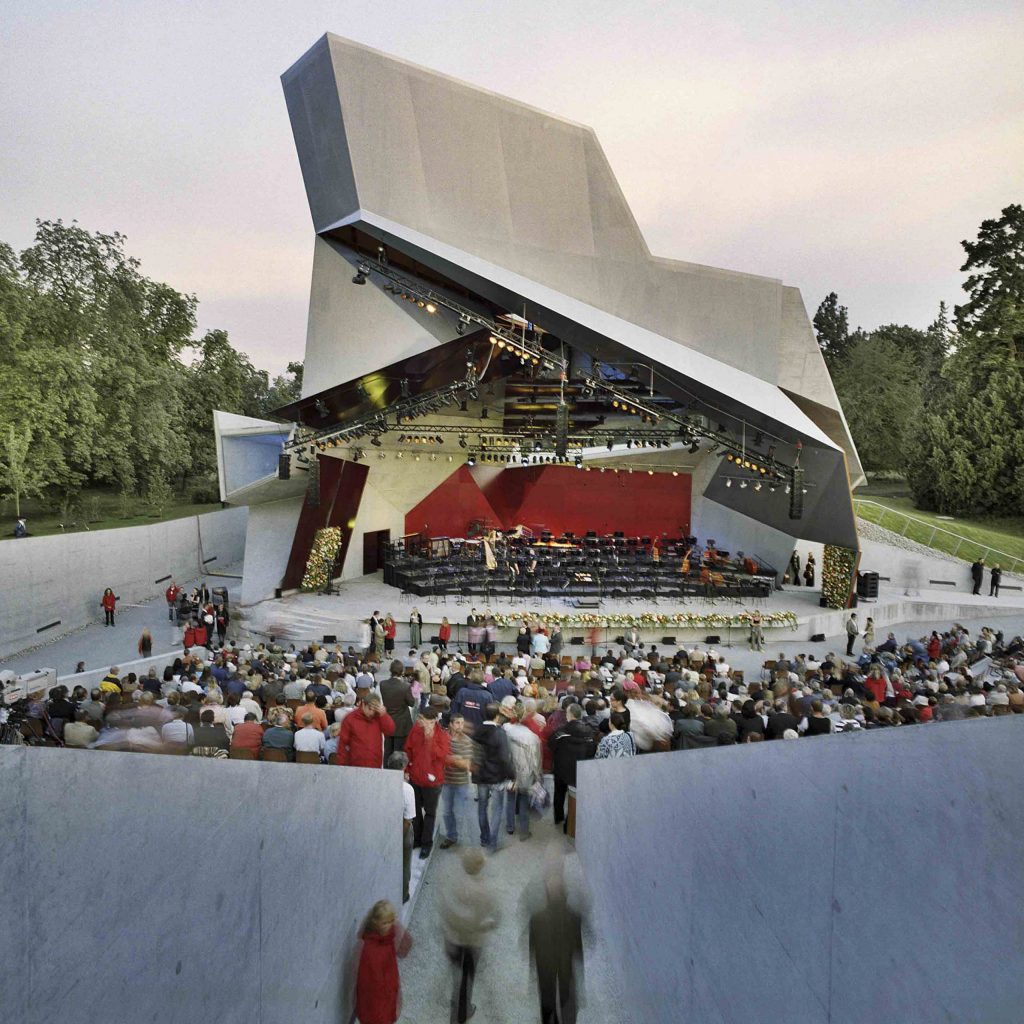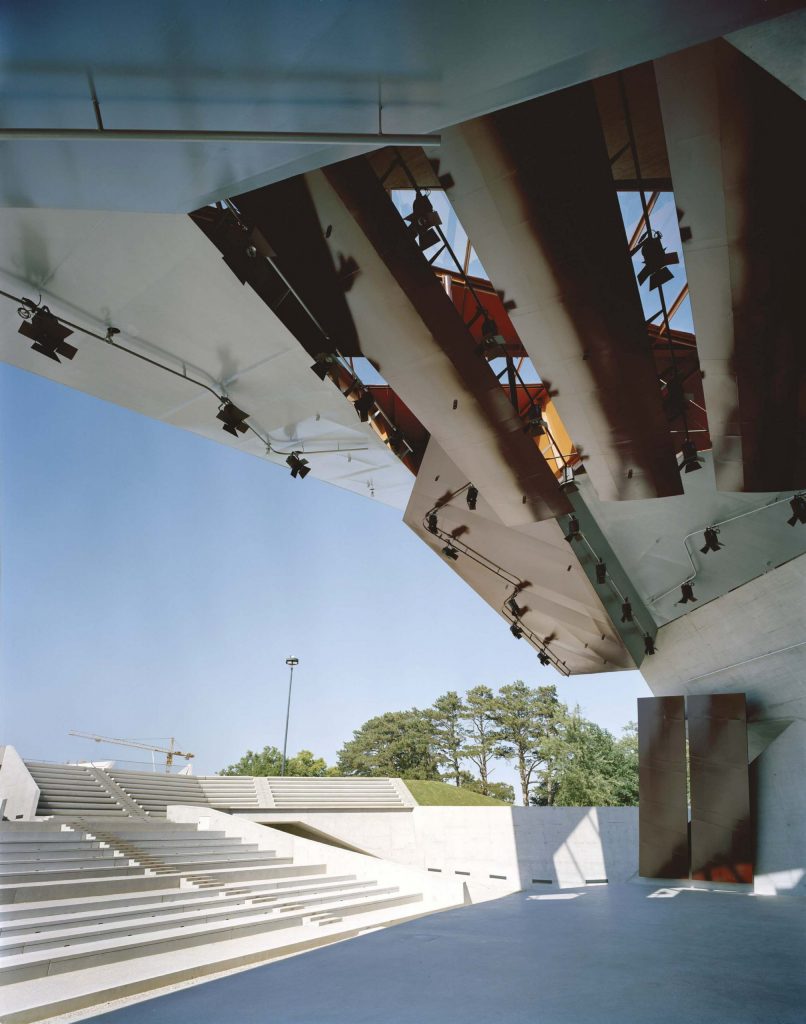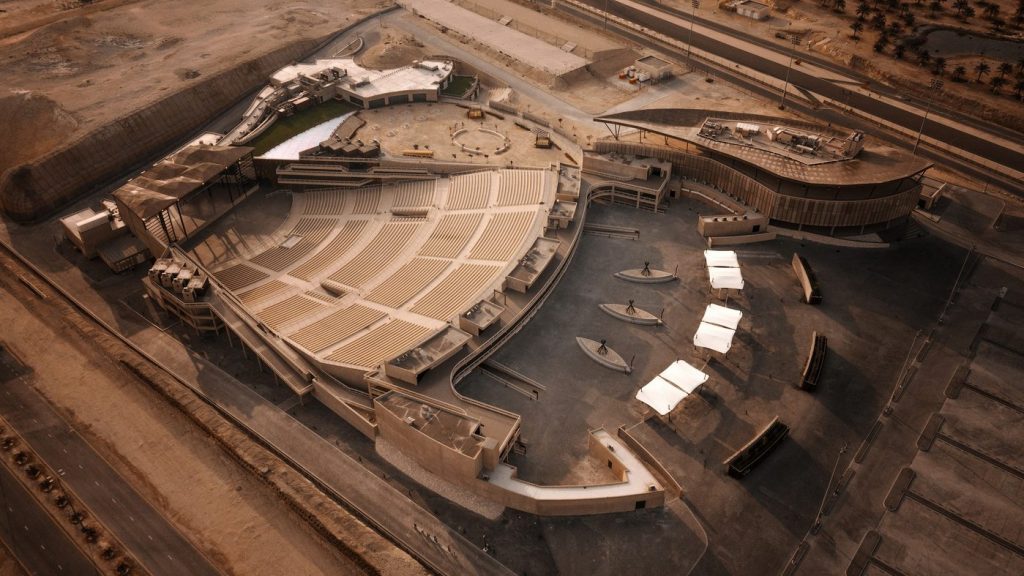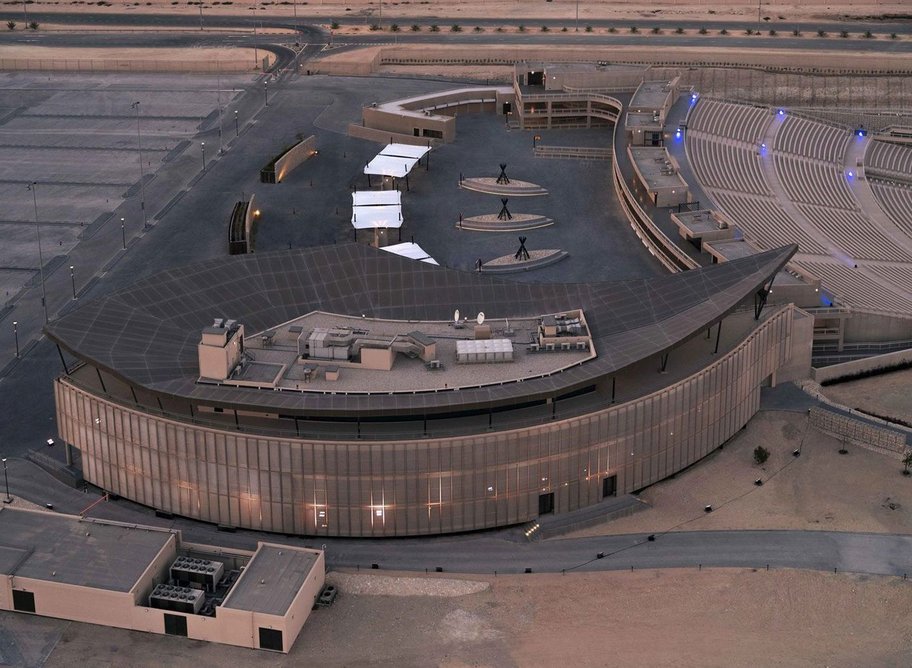An open-air structure with a central arena and tiers of concentric seats, the amphitheater originated in ancient Italy, where it was used for then popular entertainment forms, forms popular there, including gladiatorial games. Today, it is still used for different forms of immersive performance, with the city becoming an extension of the stage.
20-1024x683.jpg)
23-1024x683.jpg)
Aranya Theatre by Trace Architecture Office (also header image)
Chinese practice Trace Architecture Office (TAO) has created a complex of three buildings for the new Aranya Theatre complex at a seaside resort in Hebei, China. Since the irregular-shaped site overlooks the sea, the team sought to maintain a relationship between the theatre and the sea, streets, and urban context. By breaking up an excessively large volume into three smaller units, the project integrates harmoniously into the cityscape.
17-1024x683.jpg)
Aranya Theatre by Trace Architecture Office (TAO)
The complex provides multi-functional places suitable for different forms of performance for the community, and each of the three theaters – the Fengchao theater, A theater, and Dionysus theater, – is designed with a specific function. While the 300-seat Fengchao Theatre features professional equipment and an optimized acoustic environment and is intended for drama performances, the large and solemn 550-seat A Theatre can be used for multiple functions from theatrical performances, to concerts, exhibitions, performance shows, auto shows, and the like.
18-1024x683.jpg)
2-1024x683.jpg)
Aranya Theatre by Trace Architecture Office (TAO)
While the two rectangular buildings are connected by the lobby in the middle, the outdoor amphitheatre made of stone is located at the corner and serves as a city square. The team notes that the essence of theater architecture is to deal with the relationship between audience and performers. The choice of an amphitheatre for the project opens up the unique seaside theatre, transforming the sea and the city into a background for the stage. A wide door opens up the rear of the stage in the Fengchao theater, allowing actors to enter the stage from the street.
8-1024x683.jpg)
Aranya Theatre by Trace Architecture Office (TAO)
Not only it provides performers with a flexible space for different stage sets and positions, it can function as a space for party, relaxation and sea viewing. Facing the sea, the outdoor Dionysus amphitheatre is also the social center of the town.

Wolkenturm by the next ENTERprise
To create an open-air stage for the Grafenegg Castle Grounds in Austria, local design studio the next ENTERprise (TNE) has remodelled the existing depression in the terrain. Artificial hillocks are created by further excavating the depression and subsequently redistributing the soil at its perimeter, thus creating the auditorium tiers. Clearly distinguished from the natural terrain by their geometry, stage and auditorium nonetheless merge fluidly with the topography of the site.

Wolkenturm by the next ENTERprise
The structure is a part of the project of a contemporary reorganizing of the historical park and creating an open-air pavilion that could be used as an outstanding performance space for classical music during festival season in summer. Named Wolkenturm (German for Cloud Tower), the pavilion is a contemporary intervention in an existing scenography. The building seems to change shape, depending upon the direction from which it is approached.


Wolkenturm by the next ENTERprise
The tower itself is positioned in an existing hollow in the ground, while the stage, the auditorium and the areas of seating on the lawns create a completely new place blending with its natural surroundings. While the stage is created as a monolithic structure of fair-faced concrete, steel and glass embedded into an enveloping hillock, the audience tiers are designed using prefabricated concrete elements, compacted gravel surfaces and lawn-covered, geometrically precise hillocks. In order to optimise both the view and the acoustics, the audience is placed very close to the performers, which lends the location an agreeable sense of intimacy.

Wolkenturm by the next ENTERprise
From the main entrance the visitor tunnels through the hill and – after passing this deep and narrow space – enters the wide arena of the auditorium and the stage, the stage roof suspended above it. Conceptually, the pavilion is not bound by any particular purpose and is perceived as a stage only during performances. Its generous backstage area and, if required, the stage itself can also be used for other sorts of event.

Al Dana Amphitheater by S/L Architects
Local S/L Architects have collaborated with pre-engineering partners Ove ARUP Amsterdam and our post-engineering and supervision partners Gulf House Engineering to create the signature Al Dana Amphitheater in Bahrain.

Al Dana Amphitheater by S/L Architects
Inspire by the greatest amphitheaters of the past, the studio’s founder Marwan Lockman inserted the unique venue into a quarry on virgin desert land, in order to accentuate the desert atmosphere. As a result, the rising sun and Jabal al Dukhan (Mountain of Smoke), Bahrain’s highest point at 134m above sea level, act as a backdrop to the performance on the stage, while the prevailing worth-west wind lets the sound be carried in the direction of the audience, maximizing the efficacy of the space as a theatre.

Al Dana Amphitheater by S/L Architects
Further design highlights include the detailed study of sound dispersion in the space and low level ambient lighting, allowing for flexibility in the use of the space, whether that be for a moonlight cinema or for an international race screening.

Al Dana Amphitheater by S/L Architects
The stage is 15m tall with an up-lit limestone backdrop and a roof topography that was designed to mimic the profile of the mountain range behind. Limestone and stone-filled gabion retaining walls all around help with the scattering of sound, reducing echo. Besides, the materials palette, which includes he quarried rock sheet piles and shipping containers, as well as raw concrete, recycled rubber flooring or epoxy coatings instead of tiling and painting, has given the project has a lower energy footprint than usual for a project in the Middle East.